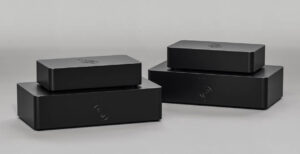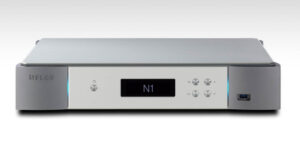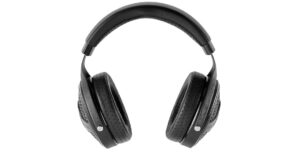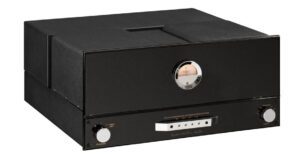
McIntosh has been around for so long that it must be viewed in the home market in much the same way that the British view Quad. Both have been around seemingly forever and have a reputation for no-nonsense, solidly built equipment that stands the test of time. McIntosh, however, does seem to have weathered the changing market conditions of the recent past with more of its ethos intact than its British counterpart. In no small part, this comes down to McIntosh’s unique and classic livery setting the brand’s products apart from all other audio equipment. The C52 preamp and MC301 mono power amps are part of a timeless design brief that remains unchanging for good reason – it’s still extremely popular the world over.

The C52 is a battleship of a preamplifier; it’s big, heavy, and festooned with knobs and switches. Despite a personal tendency toward aesthetic minimalism, you can’t help but fall under the spell of the wonderful excess of this component’s front panel, complete with VU meters and eight tone controls for the ‘analog equalizer’. It may have a classic design, but the C52 is no museum piece. Instead, this is a modern preamplifier that comes with all the latest bells and whistles, including an onboard digital to analogue converter and an MM/MC phono stage, plus all the connectivity you could want… and then some. The back panel almost resembles an AV amplifier, except that there are none of the video inputs you’d expect. Instead there are balanced and single ended in- and outputs, a phalanx of 12v triggers, and a herd of control connections for full integration into multiroom systems. McIntosh has taken the term ‘comprehensively equipped’ and run with it, for maximum flexibility and future proofing.
The built-in DAC, for example, is DSD capable up to DSD256 (and DXD 384kHz). It has five S/PDIF inputs plus USB, and McIntosh supplies a driver and USB control panel software for Windows machines, acknowledging that Macintosh (no relation) computers do not require this. McIntosh also makes an SACD/CD transport that can output DSD (MCT 450) to the C52’s MCT multipin input, which puts it in a very select group of audio companies.
Inputs are displayed on a dot matrix panel, alongside volume level expressed as a percentage – an unusual but more user-friendly approach than the commonly used ‘minus’ dB figures where zero is maximum. Every input can be named with up to 10 characters and there are various trim settings that can be applied to each; these include whether or not the VU meters are illuminated, gain, balance, mono and/or stereo, equalizer on or off, etc. In the case of the MC phono input, you use the trim control to choose a preferred impedance setting. ‘Comprehensive’ barely scratches the surface.
All these inputs and the four sets of outputs are configurable if you have the inclination, and there must be enough XLR and high quality RCA sockets on the back for pretty well any eventuality. The popularity of headphones is presumably behind the quarter inch jack output that offers HXD, a method of “improving sound locatization for headphone listening”, which is an attempt at creating the space and placement found with loudspeakers. The list goes on a bit longer but you probably have the idea by now, the C52 is not big for its own sake but in order to accommodate all that socketry and all those controls. I only have a few ergonomic gripes; the equalizer kicks in at turn on unless you have told the chosen input you don’t want it to and the remote is a system device that doesn’t cover the set up features as far as I can tell. It also has separate buttons for on and off, which foxed me!

The MC301 is a monoblock power amplifier in what for McIntosh is a slim chassis, it’s still 15cm tall, but that’s not the problem; the issue is the weight. This is a 30 plus kilo amplifier which, even for a 300 watter, seems extreme, but given McIntosh’s ‘built for the long game’ stance is pehaps not unexpected. Unusually, McIntosh solid-state amps have both mains and output transformers, or autoformers, which McIntosh uses to connect two fully differential amplifiers, so it’s a dual balanced design that avoids the more conventional approach of bridging. McIntosh reasons that if you want an amplifier that is going to deliver 300 watts into any load without going outside its ‘safe operation area’ then the tapped output approach is the only way to do this.
The MC301 is specified to deliver the same power into each of these outputs and to carry on doing so for decades, which is reassuring. I used the old ‘listen and see what gives’ approach to selecting the best output for Bowers & Wilkins 803 D3 loudspeakers, for example. This turned out to be the four ohm output, as the eight ohm option sounded a lot more expansive and delivered oodles of reverb, but seemed a little brash compared with the four ohm setting. This had a more relaxed and natural balance with clean, smooth leading edges, and tight but extended bass. Given the three ohm minimum impedance of the speaker, I didn’t try the two ohm option.
The MC301 has both balanced and single-ended in- and outputs, the latter can be used to connect your stack of power amps to a single preamp, if you have the muscle to build the stack, and a floor that can take it. A ‘Wattmeter’ on the front tells you just how much power is being delivered at any given time, but is easy to defeat with a button on the front panel.
Listening commenced with the MC301s hooked up to a Townshend Allegri controller and the aforementioned loudspeakers, a combination that produced powerful and dynamic results with the Vivace from Barenboim’s Symphony No.7 in A, Op.92 [Beethoven For All, 24/96, Decca]. There is plenty of grip available but little or no sense of the edginess that can often accompany serious power; this meant that the scale of the music and its power to charm was obvious, and that the work on the tympani did not go unnoticed. The bass is in proportion to the rest of the range but it has more control than your average power amplifier. Those 300 Watts are clearly doing what’s necessary even ‘where higher power output levels are not needed’. It’s a fluent and encouraging sound that makes it very easy to enjoy the music without being kept on the edge of your seat, so much so that I spent some time exploring the rest of this set and got into the heavy weather of the 9th for the first time in a long while.
These are not the fastest amplifiers around, and pacey rock like ZZ Top could have more tension, but if you want the music to wash over you the MC301 does a very appealing job, one that makes listening very easy. They are transparent to what comes before them as well; changing source proved that their dynamic capabilities are very much at the mercy of what’s coming down the line. Adding the C52 to the mix and using the same single ended interconnects brings a warming and smoothing quality to the sound that doesn’t get in the way of detail or the easy flow of the power amps; if anything it enhances this. The pairing digs out some fabulous low end energy on a number of pieces including ‘Naono’ from Alva Noto and Ryuichi Sakamoto’s beautiful Summvs [Raster-Noton] where waves of subtly differentiated low notes roll out of the system. This reflects a tonal balance that is a shade darker than average, which seems to work with electronic music as well as it does with orchestral. On Jeff Beck’s Live at Ronnie Scott’s [Eagle Records] there is lots of stage depth but not quite as much of the reverb that you usually get alongside a slight sense of thickening, but this does nothing to get in the way of the performance even though the degree of compression in the recording is laid bare.
.jpg)
The source for those pieces was a Melco N1A connected by Vertere HB USB cable to the C52’s DAC. Going over to the analogue inputs, using a CAD CAT PC transport with the CAD 1543 MkII DAC enhanced results quite significantly. Revealing a lot of what’s so special about the CAD pairing by letting you hear right into pieces like Ryan Adams and the Cardinals live version of ‘Hallelujah’ (on a remarkably good unofficial recording). The scale is obvious, but so is a sense of being there in the audience; this combined with the immediacy of the performance makes for a full immersion sonic experience. Another great live recording in the studio sense is Muddy Waters’ ‘My Home is in the Delta’ from the ancient but superb release Folk Singer [Chess]. This sounds a bit more sumptuous than usual and the tape hiss is less obvious, something that could probably be exposed with the tone controls if you felt the need. I tried them with a far more crude live recording, this time of the Drive By Truckers, where the kick drum was on the loud side and the guitars sounded a little bit raw. Trying the various controls it was possible to make the balance a bit more civilised, but hard to do so without losing the atmosphere and sweat that someone in the audience had managed to capture. If you have music that is less than sweetly balanced, it’s nice to have the option to dial out any nasties that get in the way of enjoying the stuff.
Moving from RCAs between C52 and MC301s to less exotically connected XLRs brought a degree of dryness to the sound that reduced the somewhat overly smooth sound via the single ended connection. The easy listenability remained as did the McIntosh’s ability to draw you into the music; detail went down a little, but this could be restored with a better balanced cable no doubt. The relaxed pacing of this pairing is more to north American than British tastes I suspect and there were times when I yearned for a bit more immediacy and speed, but equally there were plenty of others where I found that I had listened to a whole album without thinking about the sound, which ultimately should be the aim of audio equipment. The system is not an end in itself, but a conduit to music, and the better it is the more you want to listen. With the McIntosh you do. Especially if it’s Beck singing ‘Heart is a Drum’ [Morning Phase, Capitol], this always sounds big and expansive, but these amps keep it articulate, tuneful, and let it flow really nicely.
The phono stage is also rather good, with enough gain for a low output MC (Transfiguration Proteus) which is not always the case with preamps. I played ‘Niger Mambo’ by Randy Weston [African Cookbook, Pure Pleasure], a 1962 recording that can sound a little thin on some systems but here it engaged the feet as well as the heart and once again the nature of the recording did not get in the way.

I have to admit that – from a distance, at least – McIntosh never seemed like my kind of audio: those big blue VU meters, and the chrome on black finish, don’t suit my minimalist outlook on product design. But, McIntosh predates audio minimalism and will be there when minimalism gets washed away: a company doesn’t become a hugely popular choice for decades without establishing what really matters in audio, and these amplifiers deliver it in spades. If you want a system that encourages you to indulge in the music rather than the sound it makes, this comes strongly recommended.
TECHNICAL SPECIFICATIONS
C52
- Type: Solid state preamplifier/DAC with fully complementary circuitry.
- Analogue inputs: Three pairs of balanced inputs (via XLR connectors), four pairs of single-ended inputs (via RCA jacks), MM and MC inputs (via RCA jacks)
- Analogue outputs: Three pairs of balanced outputs, three pairs of single-ended outputs, one pair of single-ended line outputs, 6.3mm headphone output
- Input impedance balanced/unbalanced: 44kOhms/22kOhms
- Output impedance: not specified
- Bandwidth: +0, –0.5dB from 20Hz to 20,000Hz, +0, –3dB from 10Hz to 100,000Hz
- Gain: 15dB
- Distortion THD: 0.003%
- Signal to Noise Ratio: 100dB
- Dimensions (H×W×D): 194 × 445 × 447mm
- Weight: 12.5kg
- Price: £6,995
- MC301
- Type: solid stage mono power amplifier
- Analogue inputs: One pair of balanced inputs (via XLR connectors), one of pair single ended inputs (via RCA jacks)
- Analogue outputs: Three pairs of speaker taps (via 5-way binding posts), One pair of balanced outputs (via XLR connectors), one of pair single ended outputs (via RCA jacks)
- Power output: 300Wpc @ 2, 4, 8, or 16 Ohms
- Bandwidth: 20Hz – 20kHz
- Sensitivity: not specified
- Distortion THD: 0.005%
- Signal to Noise Ratio: 120dB balanced, 118dB unbalanced
- Dimensions (H×W×D): 152 × 445 × 508mm
- Weight: 30.4kg
- Price: £10,995 each
Manufacturer: McIntosh Laboratory Inc.
URL: www.mcintoshlabs.com
UK Distributor: Jordan Acoustics
Tel: +44 (0)1202 911 886
URL: jordanacoustics.co.uk
Tags: FEATURED
By Jason Kennedy
More articles from this authorRead Next From Review
See all
Reiki Audio SuperSwitch Master Pro + Servant Pro
- Mar 27, 2024

Melco Audio N1-S38 music server
- Mar 27, 2024

Focal Utopia 2022 headphones
- Mar 27, 2024











